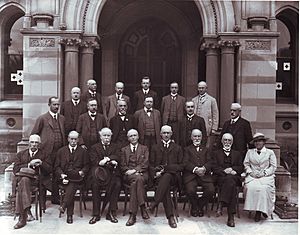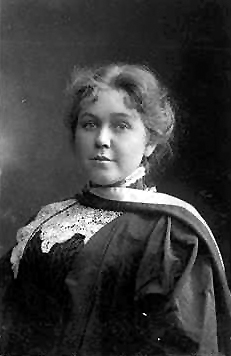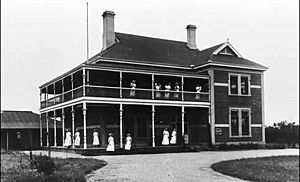Helen Mayo facts for kids
Quick facts for kids
Helen Mayo
|
|
|---|---|

Helen Mayo, c. 1914
|
|
| Born | 1 October 1878 |
| Died | 13 November 1967 (aged 89) Adelaide, Australia
|
| Occupation | Medical doctor, medical educator |
Helen Mary Mayo (born October 1, 1878 – died November 13, 1967) was an important Australian doctor and teacher. She was born and grew up in Adelaide. Helen Mayo helped many babies and mothers in South Australia.
In 1896, she began studying medicine at the University of Adelaide. After finishing her studies, she worked for two years helping babies in England, Ireland, and India. When she came back to Adelaide in 1906, she opened her own medical office. She also started working at the Adelaide Children's Hospital and the Adelaide Hospital.
In 1909, Helen Mayo helped start the School for Mothers. This was a place where mothers could get advice on how to keep their babies healthy. This group later became the Mothers' and Babies' Health Association in 1927. It grew to have many locations across South Australia. It even started a school to train nurses who specialized in caring for mothers and babies. In 1914, Helen Mayo also helped create the Mareeba Hospital, which was just for infants.
Besides her work as a doctor, Helen Mayo was involved in many other groups. She was a big part of the University of Adelaide. From 1914 to 1960, she served on the university's council. She was the first woman in Australia to be chosen for such a role. She also started a club for women students and a college where they could live. Helen Mayo also founded the Adelaide Lyceum Club, which was a group for professional women. She passed away on November 13, 1967. Many people believe her hard work made South Australia's system for helping babies and mothers very successful.
Contents
Early Life and Education
Helen Mary Mayo was born in Adelaide on October 1, 1878. She was the oldest of seven children. Her father, George Gibbes Mayo, was an engineer. Her mother was Henrietta Mary Mayo. Helen's grandfather, George Mayo, was also a well-known doctor in Adelaide.
Helen started her formal schooling at age 10 with a tutor. When she was 16, she went to the Advanced School for Girls. She finished there after one year, in 1895.
From a young age, Helen wanted to be a doctor. Even though she had never heard of women doctors, she was determined. A professor at the University of Adelaide suggested she was too young for medicine. So, in 1896, Helen first studied arts at the university.
Sadly, her younger sister Olive passed away at the end of her first year. This meant Helen could not take her final exams. When she repeated her first year in 1897, she failed two subjects. But in 1898, with her father's permission, Helen started studying medicine. She was a brilliant medical student. She was often at the top of her class. She won two important scholarships during her studies.
Medical Career and Achievements
After graduating in 1902, Helen Mayo worked as a resident doctor at the Adelaide Hospital. In 1904, she went to England to get more experience. She worked at the Hospital for Sick Children in London. To learn about helping mothers give birth, she went to a hospital in Dublin. After that, she studied tropical medicine in London. Then she traveled to India. There, she worked for a year as a midwife in a hospital for women and children.
In 1906, Helen Mayo returned to Adelaide. She opened her own private medical office. In her free time, she started working in the lab at the Adelaide Hospital. She also became an anaesthetist (a doctor who gives medicine to make patients sleep during surgery) at the Adelaide Children's Hospital.
Helping Mothers and Babies
In May 1909, Helen Mayo spoke at a meeting about how many babies were dying. She said that South Australia had a high infant death rate. She believed that mothers needed more education to care for their babies. Later that year, she heard about a successful school for mothers in London. This inspired her and Harriet Stirling to start the School for Mothers in Adelaide.
They used a room at the Kindergarten Union's office one afternoon a week. A nurse would weigh babies, and Helen and Harriet would give advice. At the first yearly meeting, a doctor criticized them. He said that unmarried women could not teach mothers, who were guided by "mother instinct." (Helen and Harriet did not have children). Despite this, the organization grew. In 1911, they bought a cottage that became their main office.
In 1927, the group became the Mothers' and Babies' Health Association (MBHA). By 1932, it had many branches all over South Australia. Helen Mayo was the main medical officer for the association until she passed away in 1967. By then, the group had a training school for nurses and its own hospital. They even started an annual lecture named after Helen Mayo to honor her. In 1981, the MBHA became part of the South Australian Government's Department of Health.
In 1911, Helen Mayo also became a clinical bacteriologist at the Adelaide Hospital. She held this job for 22 years. She learned how to make vaccines in Melbourne for this role.
Founding Mareeba Hospital
In the early 1910s, there was a big need for hospitals to treat babies in South Australia. The Adelaide Children's Hospital would not treat children under two years old. This was because of the risk of spreading infections. In 1913, Helen Mayo and Harriet Stirling held a meeting to discuss building a hospital for these young children.
Some people doubted if it was possible. But the group raised some money. They suggested to the Children's Hospital board that they build a separate ward on the hospital grounds. The board said no to this idea. So, Helen Mayo and her group rented a two-story house in St. Peter's. They opened a hospital for infants there in 1914.
The hospital faced financial problems. Eventually, the state government took over. They moved the hospital to Woodville and renamed it the Mareeba Hospital.
Helen Mayo was key in setting up Mareeba Hospital and its rules. She worked there as an honorary physician. From 1921 to 1946, she was the honorary responsible officer. To stop infections from spreading, she made strict rules. Each baby had their own locker for equipment. Nurses used special gowns for each child. Blankets, bottles, and floors were all cleaned very carefully. Mareeba eventually became a 70-bed hospital. It had a surgery unit and a ward for premature babies.
Later Medical Work
In 1919, the Adelaide Children's Hospital looked for new doctors. Helen Mayo first thought her gender would stop her from getting a job. But a surgeon named Henry Simpson Newland suggested she apply. That year, she was appointed as an honorary Assistant Physician. She was in charge of helping outpatients (patients who visit the hospital but don't stay overnight).
Helen Mayo had many jobs at once. She worked at the Royal Adelaide Hospital, the Children's Hospital, and Mareeba Hospital. She also had her private practice. In 1925, she started working on her Doctor of Medicine degree. She used her experiences as a bacteriologist at the Adelaide Hospital for her thesis. She had to write it on weekends because she was so busy.
The next year, she became the first woman to earn an MD from the University of Adelaide. She was then made an honorary physician for inpatients (patients who stay overnight) at the Children's Hospital. She also became a clinical lecturer at the University of Adelaide. In May 1935, Helen Mayo was given the title of Officer of the Order of the British Empire (OBE). This was "for services in connection with maternal and child welfare in the state of South Australia."
She retired in 1938. She became an honorary consulting physician at the Children's Hospital. But when World War II started, she returned to the hospital. She worked as a senior paediatric adviser. At the same time, she helped organize the Red Cross blood donation service.
Other Important Activities

In 1914, Helen Mayo was chosen to be on the Council of the University of Adelaide. She was the first woman in Australia to be elected to a university council. She held this position for 46 years.
In 1922, she founded the Adelaide Lyceum Club. She was its first president. This club was a place for women who were leaders in their fields to meet. Its goal was to "advance the status of women in the world of arts and letters."
Helen Mayo also worked hard to help female students and graduates at the University of Adelaide. In 1909, she led the creation of the Women Student's Club. In 1921, she started efforts to unite all the student groups at the university. This led to the Adelaide University Union. She also played a big part in building the Lady Simon Building for the Women's Union. She helped found St. Ann's College, where she was the chairperson from 1939 to 1959.
Helen Mayo passed away on November 13, 1967, at 89 years old. The Medical Journal of Australia called her "the doyen of medical women in South Australia (and most probably Australia)." They said she was responsible for how well South Australia's infant health system worked. A street in Canberra and a federal voting area are named after her.
Family
Helen Mayo never married. Her brothers were the psychologist Elton Mayo and the judge Sir Herbert Mayo.
Images for kids
See also
 In Spanish: Helen Mayo para niños
In Spanish: Helen Mayo para niños







